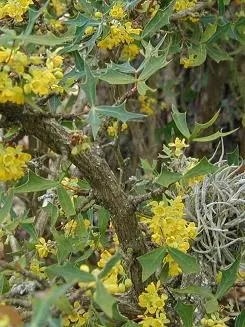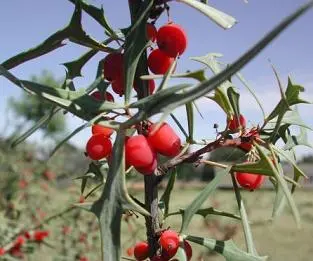Author: Bill Ward
Probably the earliest harbingers of spring in our yard are the agarita bushes. They are the first shrubs to bloom, with tiny bright-yellow flowers. Soon after that, they are putting on small round fruit that by early summer have gradually turned from green to red. Those berries make great jelly.
Agarita (Berberis trifoliolata) is an evergreen holly-like shrub that looks good all year in a variety of landscape settings. Agarita is highly drought-tolerant, and the white-tail deer ignore it, at least in my neighborhood. It is long overdue for agarita to be a Plant of the Month for Operation NICE! (Natives Instead of the Common Exotics!).

Agarita is a more-or-less rounded shrub that normally gets three or four feet high, but can grow a few feet taller. It has tough compound leaves with three leaflets, each of which has several sharp points. The sticky evergreen foliage makes this a good substitute for the red-berried Burford holly, an exotic so commonly planted in local landscapes. Agarita doesn’t seem to be bothered by the “powdery mildew” that commonly infects Burford holly, and the red berries of agarita taste good.
A lot of home builders remove agarita as one of the trash bushes on new lots and thereby destroy a free “built-in” landscape shrub. Our builder, my brother, generally removes as little natural vegetation from a lot as possible. We, therefore, have four or five large agaritas that happened to be well placed for our landscaping. They came with the place, and they never have had to be watered.
Many people, I among them, think that agarita berries make the best jelly in Texas. Gathering enough of the quarter-inch berries from among the sharp-pointed leaves is a little discouraging. However, there are ways to get around the tedious task of picking the fruit one berry at a time. Rebecca Rogers turns an open umbrella upside down under a berry-laden agarita and then gently thrashes the bush until she has an umbrella full of berries. Another way is to lay a cloth under the bush to collect the fruit knocked down during the thrashing.
Agarita is common on dry flats and slopes in much of the western two-thirds of Texas as well as in New Mexico, Arizona, and northeastern Mexico. It is one of the most common bushes in the Hill Country, and so it usually does just fine in the dry calcareous soils of this area. The Boerne Chapter of the Native Plant Society of Texas provides free planting and care instructions for agarita at nurseries participating in Operation NICE! (Hill Country African Violets and Nursery, Maldonado Landscape and Nursery, and Barkley’s Nursery Center).

Another Berberis that can be an interesting yard plant is Texas barberry (Berberis swaseyi). This less-abundant cousin of agarita is endemic to the eastern and southern Hill Country from Williamson County to Real County. However, it is probably scarce in Kendall County. Has anyone seen it in Kendall County?
Texas barberry differs from agarita in having compound leaves with 5-9 leaflets. But similar to agarita, the leaflets have several sharp points along the leaf edges. Barberry has small yellow flowers, followed by little berries that are yellow with red wash. In the fall, barberry leaves turn deep purple-red.
Barberry is more difficult than agarita to find in the nursery trade. Some years it is available at Cibolo Nature Center’s Mostly Native Plant Sale in April. Another nearby place I’ve seen it for sale is Medina Gardens Nursery in Medina. Barberry can be a nice-looking evergreen shrub for landscaping, but judging from how slowly it grows in our yard, it may be a plant for younger homeowners.
